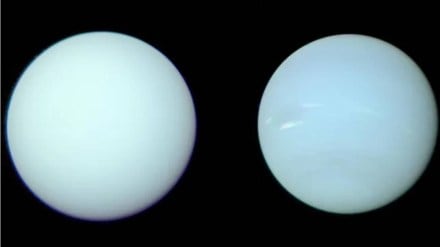New research has revealed that the true colors of Neptune and Uranus are surprisingly similar, challenging the previous belief that they were distinctly different. NASA’s Voyager 2 mission, which conducted flybys of Uranus in 1986 and Neptune in 1989, provided the first detailed images of these two ice giants in our solar system. Voyager 2 is unique as the only spacecraft to have approached both planets.
In the images captured, Uranus appeared with a pale cyan color, while Neptune displayed a striking deep blue hue. The spacecraft captured separate color images of each planet, and researchers combined these single-color images to create composites. The images of Neptune were enhanced to reveal the white clouds and winds in the planet’s atmosphere.
The lead author of the study from the University of Oxford, Professor Patrick Irwin, shared insights, stating, “Uranus is still bland and rather boring looking, but Neptune looks fairly washed-out as well when you do the full true color reconstruction.”
The color of the ice giants has long been associated with the presence of methane in their atmospheres, with methane absorbing green and red light. Previous research suggested that Neptune appeared slightly bluer than Uranus due to the greater transparency of aerosols in one layer of its atmosphere.
However, recent research challenges these assumptions by reexamining images created from data collected during the Voyager 2 flybys in the 1980s. It turns out that Neptune’s deep blue appearance in those images was a result of contrast enhancements to highlight fainter features.
Professor Irwin emphasized, “Applying our model to the original data, we have been able to reconstitute the most accurate representation yet of the color of both Neptune and Uranus.” This revelation highlights the importance of revisiting and reinterpreting existing data to refine our understanding of celestial bodies in our solar system.
